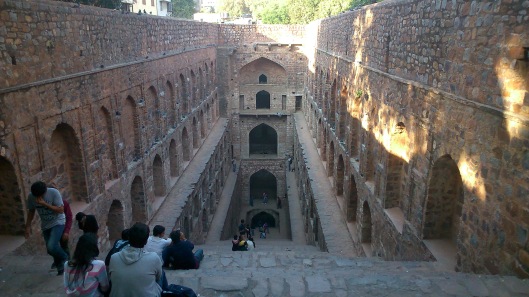
“Baoli” means step wells which were constructed mainly to cope up with the blistering Indian summers and fluctuating water availability. The concept of creating Baoli dates back in time to 600 A.D, however, it flourished during the medieval times in India. The meticulous architectural concept and detailing with which these ancient water reservoirs are constructed even beats the present day technology. “Baoli” were much more than just a water reservoir in its golden days; it was candid retreat for the locals from blazing summers and a gathering place of evening gossips. Delhi alone is believed to have more than 100 small and big Baoli, but most of them are ruined to such an extent that it cannot be recognized and nearby residents have transformed them into natural garbage bins.
Below are the few remaining “Baolis” of Delhi which are still recognizable as step wells but have lost its importance and prominence in time.
HAZRAT NIZAMUDDIN BAOLI
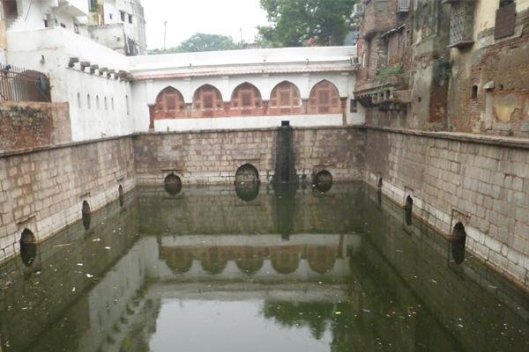
The “Baoli” is located exactly at the rear side of the world renowned shrine of Sufi Saint Hazrat Nizamuddin Auliya. It was given a facelift in 2009, when it was cleaned for the first time in 800 years (built in 14th century). During the process of facelift, it was discovered that water from seven underground streams feeds this reservoir. However, in spite of its holy character and enjoying a protected monument status under Archaeological Survey of India (ASI), the nearby residents often throw garbage into the Baoli precincts.
Apart from having a sacrosanct and holy status, it is famous among the locals for an interesting anecdote associated to it. It is said that when Hazrat Nizamuddin Auliya commenced the construction of the Baoli, then Emperor Ghiyasuddin Tughlaq was building his fort at Tughlaqabad and he required workers.
The workers instead chose to side with the Sufi Saint in construction of Baoli. The annoyed king threatened to punish Nizamuddin on his return from Bengal. However, king could never reach Delhi and died at Afghanpur, a one day march from Delhi. The renowned Hindi phrase “Dilli abhi dur hai” also has its origin from this story.
BAJON KI BAOLI

Built in 1516 by Daulat Khan, the governor of Punjab during the reign of Sikandar Lodhi, the Rajon Ki baoli is the one of jewels of Mehrauli Archaeological Park. It owes its name to mason who used the same for some time.
The Lodhi’s are accredited to be immaculate architectures and the fact stands proved. A distinct feature of the baoli, is one cannot see the flight of steps which narrows down as you go deeper into the well until he/she stands just above the first step.
The beautiful symmetrical colonnaded arch opening on both side of the baoli add more elegance to its beauty. The water in the baoli has almost dried up and lump of garbage, leafs and wrappers could be seen in it. It also has a mosque adjacent to it. It is believed that in its glorious time, it was favourite halt for the travellers, businessman etc. who could enjoy, relax and pray in its vicinity. Although, its glory has long gone, but it still manages to attract passerby and some wanderers like old times.
GANDHAK KI BAOLI
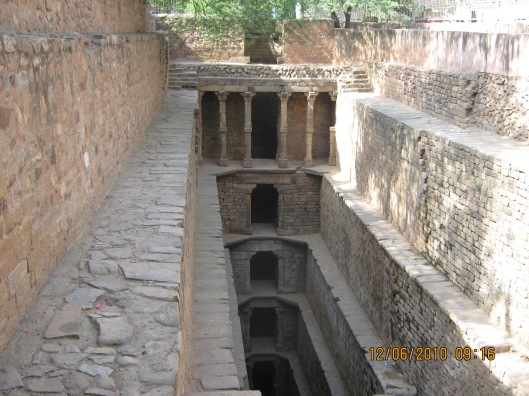
Also known as the “Diving Well”, the baoli is the second jewel of the Mehrauli Archaeological Park. Built during the reign of Iltumish, the step well is located at a walking distance from the first tree tower of Islam in India i.e. Qutub Minar. The name Gandhak (Sulphur)is attributed to the mild odour of sulphur in the water of the baoli which is also believed to have healing properties.
It is a simple yet well-designed five storied structure and one can easily sense the drop in mercury as he/she moves down into the well. The architecture does not have arched opening on the sides as seen in other baolis. Both the ledges on the sides of baoli culminate at a cylindrical well at the end which has niches in the walls for lighting torches in night. The monument lies in dilapidated state with crumbled walls and broken steps which make it little difficult to access but still locals enjoy its ambience in summers.
FEROZSHAH KOTLA FORT BAOLI
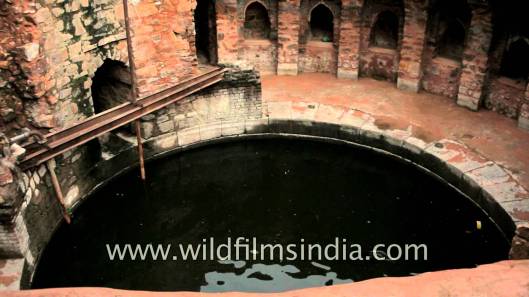
The Tughlaq Dynasty is often credited for building of number baolis in and around Delhi. Among the distorted ruins of Ferozshah Kotla fort, also known as “City of Djinns”, the circular baoli located near the Jami Mosque needs no recognition.
It is the only circular shaped baoli existing in present times in Delhi. The architecture of the baoli is bit different from the other baolis in Delhi. Made out of red stone, it does not have any steps but circular porch around the main reservoir. The circular porch is circumscribed by the symmetrical arches. It also has first floor exactly on the same pattern.
The water is used by the authorities for the nourishing the park and it has a number of plump fishes flourishing as no one bothers to toast them. The access to baoli was recently closed for general public as local boy fell from the first floor and sustained major injuries.
RED FORT BAOLI
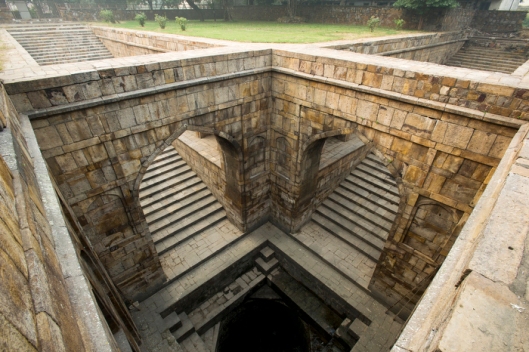
The baoli which we today see in a clean and pristine form served as garbage dump by the local army personnel ever since Independence. Few years back, the Archaeological Survey of India (ASI) took it from the Army and restored it. It has a distinct structure with stairs from two sides at 90 degree capping at the circular water pit bounded by the rectangular ledges. The stairs of the baoli are slightly elongated as compared to other making it easier and comfortable to access.
It is widely mistaken to be built by the Mughals, but was actually constructed by Tughlaqs. The question is extensively baffling as both Tughlaqs and Mughals ruled in different centuries. But it is an accepted fact that Red Fort was built on the ruins of earlier city, hence, there are many chances of its existence prior of construction of Red Fort. It was also used as prison by the British for members of Indian National Army (INA). Names of INA soldiers were found while restoration by the ASI.
AGRASEN KI BAOLI

I saved the best one for the last. Tucked amid the busiest commercial arena of Delhi i.e. Connaught Place, the baoli still remains mysterious among the locals. This is an intelligently carved 60 meters deep and 15 meter wide piece of architecture built from rubble and dressed stones. The stairs (103 stairs to be accurate) endlessly goes deep down into the well to its base and leaves everybody stumped when looked up from the base. All the three levels of the baoli are accompanied by arched corridors and chambers on both the sides.
Till late 70’s the baoli was filled up to all three levels and local boys used to dive in to beat the summers but extensive construction around area has dried it up and its almost forgotten by Delhites. The historians are sceptical about its creator but when it comes to attractiveness, it’s a unanimous winner. The fluttering of pigeons who have nestled themselves in the cavities of the wall of baoli further enhances its elegance.
KHARI BAOLI
Well many of you must been wondering I might not have been in my senses to include this one in the list. The mere name of it recalls the strong aroma of spices which might sneeze out many. But back in time, the area had a baoli in its precincts. Nothing of the baoli remains on date but its name is derived from two Hindi words meaning a step well with saline water. This one was just for the knowledge!
The baolis today attract only handful admirers which often bump in here for some solace from the hustle-bustle of the city or just simply spend some time with friends. But people/tourists who are looking for some unplumbed and offbeat places to explore in Delhi, it will turn out to be heaven for them.

Kaushal Mathpal is an Advocate practicing in Delhi Courts in India but also has a flair for travelling. When he’s not in a courtroom, he enjoys exploring various parts of India and the surrounding region. He also writes on his blog http://rediscoveryourdreams.wordpress.com/ and you can follow him on Twitter @KaushalMathpal.








